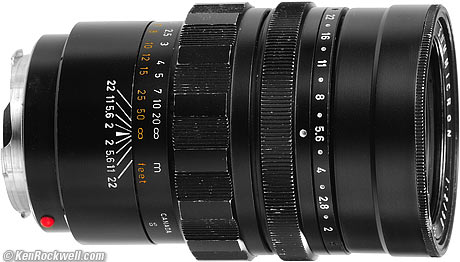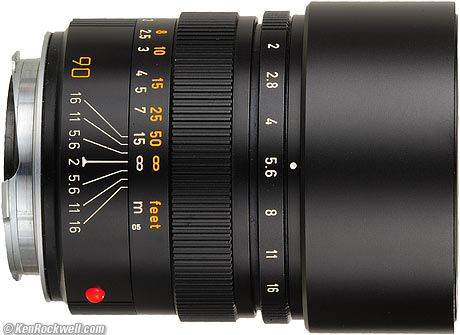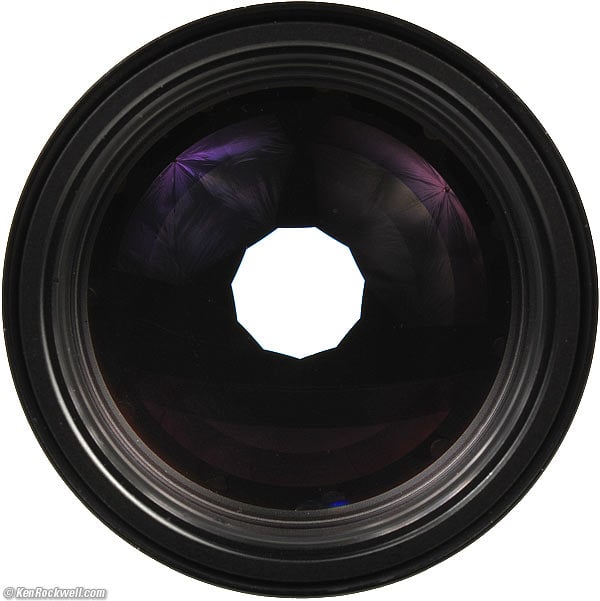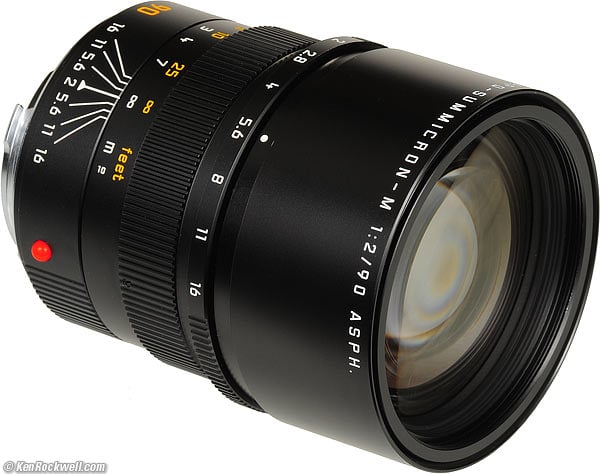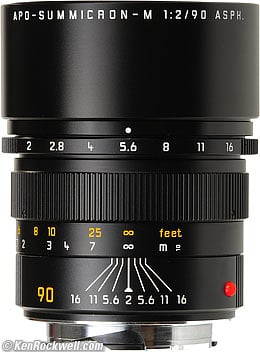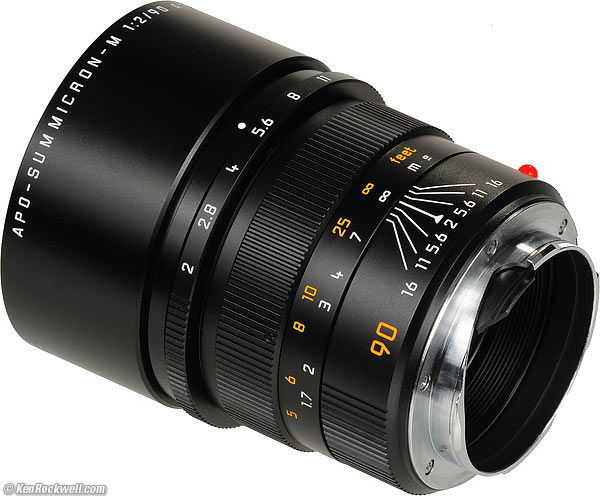Home Donate New Search Gallery Reviews How-To Books Links Workshops About Contact
LEICA 90mm f/2 ASPH
APO-SUMMICRON-M 11884 (1998 - )
The World's Highest Performance Lens.
© 2011 KenRockwell.com. This page best with Corporate S regular and bold activated.
Intro Specs Performance Usage Compared Recommendations
LEICA 90mm f/2 APO-SUMMICRON-M ASPH (11 884, 55mm filters, 16.7 oz./473g, about $3,700). enlarge. I got this one at Adorama. I'd also suggest getting it at Amazon, B&H or Calumet. If you can't wait for a new one, used ones are readily available for $3,500-$4,500 (see How to Win at eBay). This free website's biggest source of support is when you use any of those or these links when you get anything, regardless of the country in which you live. Thanks! Ken.
July 2011, March 2009 more LEICA Reviews LEICA Lens Reviews
Other LEICA 90mm f/2 lenses 90mm f/2.8 Lenses Compared
LEICA Lens Names How to Afford Anything
Example Photos: Route 66 (February 2009) and Volcano Country (May 2009).
| Optics: | |
| Mechanics: | |
| Ergonomics: | |
| Usefulness: | |
| Availability: | |
| Overall: |
Ideal Uses
Fantastic anyplace you need a medium tele lens, and don't mind the extra size (55mm filters) and weight (475g total) compared to slower 90mm lenses.
Not for
Anyone demanding the smallest, lightest lens. For this, use the 90mm f/2.8 TELE-ELMARIT-M (1974-1990, 39mm filters, 225g and about $400 used) or today's newest LEICA MACRO-ELMAR-M 90mm f/4 (39mm filters, 223g and about $2,000 new).
It's not good for photographing bright city lights at night at f/2; it has some weird coma which is normally invisible, but if you try photographing subjects at f/2 with extremely brilliant points of light, it can look much worse than more ordinary lenses. Either stop down to f/4, or try a different lens.
Introduction top
Intro Specs Performance Usage Compared Recommendations
|
I personally buy from Adorama, Amazon, Ritz, B&H, Calumet and J&R. I can't vouch for ads below.
|
The LEICA APO-SUMMICRON-M 90mm f/2 ASPH is the highest performance medium tele lens I've ever used. In fact, I've never used any lens with higher performance, regardless of focal length.
Why? The LEICA 90/2 APO is ridiculously sharp, even wide-open at f/2, and even in the farthest corners. Not only does it stay as sharp as the aperture is opened, it stays as sharp in the farthest corners.
My Nikon lenses, like the 85mm f/1.4 AI-s, aren't as sharp at the larger apertures, and the 85mm f/1.4D AF is soft in the corners, where it doesn't matter that much anyway. The excellent Nikon 85mm f/1.8D AF is also very sharp at all apertures, but still not as unflinchingly sharp at all apertures as this LEICA 90mm f/2.
This LEICA 90 2 doesn't have any visible distortion, and it has great bokeh.
The LEICA 90 ASPH's optics are beyond fault, and so are its ergonomics and mechanics. It feels great in-hand; the focus ring is right where you want it and its pitch makes perfect, precise, fast focus easy. Likewise the aperture ring falls right where you expect, and it can be set with a fingertip as you keep your eye on the finder.
The Germans miss nothing. See the how the lens markings on the telescoping lens hood line up perfectly in my photo? I didn't have to line them up; the hood is keyed so that it doesn't rotate, so the markings are always visible without having to spin the lens around to find them!
Since the LEICA APO-SUMMICRON-M 90mm f/2 ASPH has so many acronyms as part of its name, I'll refer to it as both the 90mm APO and the 90mm ASPH. I'm talking about the same lens, without typing out LEICA APO-SUMMICRON-M 90mm f/2 ASPH each time.
Actual Size introduction top
Presuming you have a standard 106 DPI monitor, this is its actual size, which is 3-1/4 inches (83mm) long overall:
LEICA 90/2 ASPH, actual size. enlarge.
All of the illustrations in this review have been enlarged a little to fit the page.
History introduction top
1931
LEICA has made slower 90mm lenses for its rangefinder cameras since 1931.
1958-1980
LEICA 90mm f/2 SUMMICRON, actual size (this sample from 1970). enlarge.
LEICA's first 90mm f/2 SUMMICRON came out in 1958. It has 6 elements in 5 groups. It's a fantastic performer, even today, but for some reason, it's among LEICA's most hated lenses. Therefore I was able to pick this one up for under $250, delivered!
This first 90mm f/2 was made in Canada. It takes 48mm filters and weighs 605g as I measure it. (LEICA specified 680g.) It has a built-in two-stage telescoping hood.
LEICA today tries to make you think that this was an awful lens so that LEICA can sell new lenses.
See page 65 of today's "LEICA M Lens Secrets," where the clever marketing people pull a rare double-switch and claim "Its performance at full aperture was moderate, so the ever-creative sales people invented the notion of a portrait lens."
Nonsense, this beater Canadian 90mm f/2 is sharp at f/2, just as LEICA's sales material claimed for it back when it was the best LEICA had to sell.
To quote LEICA's own sales material of its time (LEICA M5 sales brochure 110-87e, VI/75/DLX/w (1975)), this 90mm "at f/2 offers outstanding performance over the whole image field" and "Besides exceptional definition it offers high resolution and optimum image contrast." In 1965, LEICA describes this lens' performance as "brilliant images with crisp edge-to-edge sharpness from f/2." (LEICA lens brochure 11-34f, October 1964.)
The only reasons I don't shoot with this old 90mm f/2 is that it's too big and heavy, its fluted, scalloped focus ring cuts into my fingers, and most importantly, because my sample's focus needs some adjustment to match my particular bodies perfectly.
1980 - 1998
LEICA 90mm f/2 M (non-ASPH, non-APO). enlarge.
LEICA made a 90mm f/2 that looks very similar to the 90/2 APO ASPH, but is neither apochromatic nor aspherical.
It also takes 55mm filters, but weighs 485g. It has 5 elements in 4 groups and is 77mm long.
I have not tried this lens. LEICA's same "LEICA M Lens Secrets" claims this lens is inferior to the APO as well, but seeing how wrong it was about the original 90/2, I'll let you know if I get to try one of these versions.
1998 - today
This 90 APO ASPH comes out as LEICA's premier 90mm lens.
Specifications with commentary top
Intro Specs Performance Usage Compared Recommendations
Name Focal Length Angle-of-View Optics Diaphragm
Filter Thread Close Focus Maximum Repro Ratio Caps
Hood Size Weight Introduced Part Numbers Price
Name specifications top
LEICA calls this the LEICA APO-SUMMICRON-M 90mm f/2 ASPH, model number 18 884.
APO is short for apochromatic, by virtue of its use magic glass similar to Nikon's ED glass and Canon's UD glass.
SUMMICRON means nothing except a LEICA-brand f/2 lens.
M means for LEICA's M-kameras.
ASPH is short for aspherical.
Focal Length specifications top
Actual (design) Focal Length: 90.9mm.
The actual focal length will vary with production tolerances. The exact actual focal in millimeters anr tenths is the mysterious number on the focus ring to the right of the "m."
For instance, the lens shown here has a mystery number of 10, meaning = 91.0mm.
(Equivalent on the LEICA M8 (half-frame): 120mm.)
(Equivalent on the Epson R-D1x (half-frame): 135mm.)
Angle of View (full-frame 35mm) specifications top
27º Diagonal.
23º Horizontal.
15º Vertical.
Optics specifications top
5 elements in 5 groups.
One ground aspherical surface.
Multicoated.
Diaphragm specifications top
11 blades.
LEICA 90mm f/2 ASPH at f/5.6. enlarge.
Blades are straight to f/2.8, inwardly curved from f/3.4 - f/8, and straight from f/9.5 - f/16.
Stops down to f/16.
Half-stop clicks.
Filter Thread specifications top
55mm.
Germans call this E55 and 55E, but it's the same standard 55mm (0.75mm pitch) filter available everywhere.
55mm is larger than most of LEICA's lenses, but it is the same as LEICA's 21mm f/2.8 ASPH. This is handy, because I can quite happily shoot with nothing other than these two lenses for an unlimited amount of time (examples).
See more about using step-up rings to 58mm under Filters.
Close Focus specifications top
Marked: 3.5 feet and 1 meter.
Actual measured: just inside 1 meter or 39."
Maximum Reproduction Ratio specifications top
1:9.
Caps specifications top
Any 55mm snap-on front cap works great.
The real LEICA 14 289 front cap is designed so that you can't pull out the hood and shoot with the cap left on. Clever, those Germans.
The 90mm f/2 APO ASPH uses the standard LEICA 14 269 rear cap.
Hood specifications top
The sliding hood is built-in.
It is keyed so that it doesn't rotate. This way the engraved lettering doesn't spin around.
Size specifications top
Length
77.3mm extension from flange, measured at infinity. (78mm specified.)
84.2mm overall, measured.
Diameter
63.45mm, measured.
64mm, specified.
The hood is the widest part.
Weight specifications top
Naked lens, no caps: 16.675 oz. (472.77g), measured.
LEICA specifies "approximately 500 g."
Introduced specifications top
1998.
Product Numbers specifications top
Black anodized lens, complete: 11 884.
Black-painted lens (red footage markings), complete: 11 636.
Titanium-painted (titanisiert) lens, complete: 11 632.
Each includes the boxed lens, paperwork and:
55mm Front Cap: 14 289 ($30 if bought separately).
Rear Cap: 14 269 ($27 if bought separately).
Fitted Leather Case.
Price specifications top
2011, July, USA: $3,700.
2010, April, USA: $3,700.
2009, March, USA: $3,500.
In the USA, there was an additional $300 Lens Rebate valid through much of 2008 and early 2009, making it $3,200.
Used ones sold for about $1,500-$2,500 in 2009, but when the LEICA M9 came out and every rich guy bought one, the used price in 2011has risen to $3,500-$4,500 since new ones rarely are found.
LEICA 90 2 ASPH. enlarge.
Performance top
Intro Specs Performance Usage Compared Recommendations
Overall Aperture Ring Bokeh Coma Depth-of-Field Scale
Diaphragm Linearity Distortion Ergonomics Falloff Filters
Finder Blockage Mechanics Sharpness Sunstars
Overall performance top
This LEICA 90mm f/2 APO-SUMMICRON-M ASPH is the world's highest-performance 90mm lens.
It's fast, sharp and doesn't have any visible distortion.
The choices to consider when buying one is the fact that it's bigger than other optically fantastic, but smaller, slower and less expensive lenses.
For the LEICA Man who doesn't mind the larger size, weight and 55mm filters, this 90mm f/2 ASPH is his lens.
Aperture Ring performance top
The aperture ring is perfect, like most current LEICA lenses.
One fingertip is all you need to adjust it by feel.
Bokeh performance top
Bokeh is the character of out-of-focus areas, not simply how far out of focus they are.
The 90mm f/2 APO ASPH has excellent bokeh for out-of-focus backgrounds in the center of the image.
This is wonderful, because the 90/2 also can throw things very far out of focus.
We have the best of both worlds: the ability to throw things far out of focus, and the great bokeh keeps these backgrounds soft and undistracting.
We have to pay for our superb bokeh somehow, and as expected, if you have foreground items out of focus, bokeh is terrible. This shouldn't be a problem, since fuzzy foregrounds are already a bad idea. Our eyes almost always find fuzzy foregrounds very distracting and unnatural.
The center is great, but background bokeh is only fair in the corners at f/2.
Coma performance top
Coma is when points of light in the corners grow into weird-shaped blobs.
This is where we find some oddball things with this highly advanced aspherical 90mm f/2 lens.
Coma is astoundingly invisible under almost all conditions. Compared to Nikon SLR lenses like the 85mm f/1.4 AI-s, it just isn't there.
Here's the catch: while coma is invisible most of the time under conditions in which we would see coma with more conventional lenses, if you push it with some extremely bright light sources, coma goes nuts!
In other words, if we look at point-spread functions, this LEICA 90mm ASPH has much less coma intensity at any point near the intended image point compared to a conventional lens, however the total area of the point spread is much larger than a conventional lens. This means if you hit it with points of light so bright that you can see the broader, but dimmer, coma, it looks horrible compared to a conventional lens.
Here's how bad you can make it look:
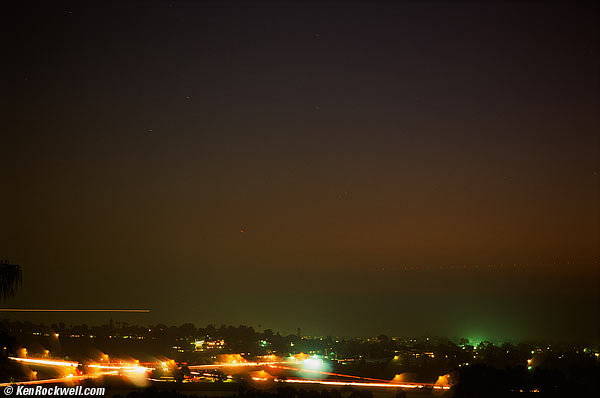
Full image, f/2. 90 APO on Fuji Velvia 50, 32 seconds. Note saggital coma flare along bottom and on left.
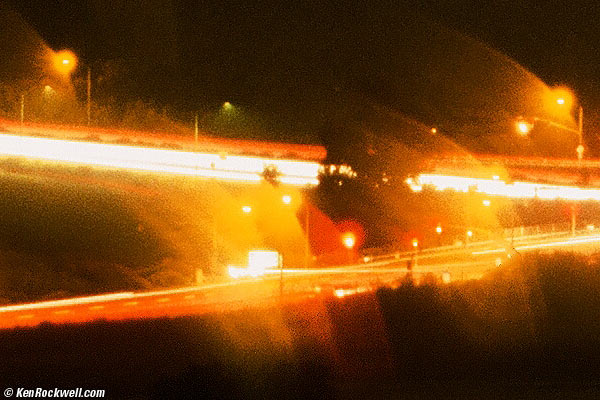
Crop from lower left of above 3600 DPI scan (111 x 167 microns total) at 100%, f/2 at 32 seconds.
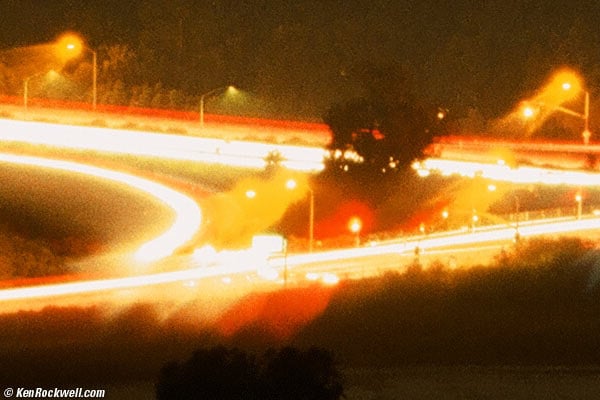
Same crop as above, except f/2.8 at 80 seconds.
Coma goes away at f/4.
For those of you who are geeks like me and look for this stuff, this is the weirdest coma I've ever seen. I forwarded these images to a noted American optical designer, who confirmed this as very high-order coma, probably 9th or 11th order, or possibly even elliptical coma.
We can see this from the very large included angle of the flare. Lower order coma has a smaller included angle; the angles here approach 150º, which is unusual and virtually impossible to correct.
3rd order coma has an included angle of 60º. Fifth order is 84º. Seventh order is 97 º.You won't see this on star trails; stars aren't as bright.If distant street light photography is your thing (these lights are over a mile (2km) away), use a different lens, or stop down to f/4.I've found the best lens for this sort of shooting is the 90mm f/2.8 ELMARIT-M (1990-2008) or today's 90mm f/2.5 Summarit-M (2008-).If you compare this to the Nikon 85mm f/1.4 AI-s, you'll see that the coma is better controlled in the Nikon, but also much brighter in the Nikon. This makes the Nikon much less sharp most of the time, since each image point is surrounded by the brighter coma flare that can be seen, while the LEICA 90 APO has a much smaller central spot size and therefore much sharper performance over every other condition where we're not deliberately pointing it into unshielded street lights.
Summary: If you don't make minute-long exposures of unshielded street lights at f/2, the coma performance of the LEICA 90mm f/2 APO ASPH is fantastic. I have to go out of my way to show what I did here.
Depth-of-Field Scale performance top
Even though the total angular rotation of the focus scale isn't much broader (in degrees) than my tiny 90mm f/2.8 TELE-ELMARIT-M (1974-1990), I noticed that the depth-of-field scale of this 90mm f/2 ASPH is about twice as wide.
This is handy, but how can this be?
It turns out that the slightly larger angular travel of the focus ring, combined with the larger diameter of the focus ring, results in a far more legible depth of field scale than on smaller lenses.
The scale is only slightly longer than on the 90mm f/2.8 ELMARIT-M (1990-2008), and about the same as on the Canadian 90mm f/2 SUMMICRON (1958-1980).
Diaphragm Linearity performance top
My M7 agreed exactly as I tried every half-stop.
This shows a well-made lens.
It's not important when using TTL exposure meters, as with most modern cameras, but is important if you're using an external meter.
On my sample, pushing it just a hair past f/16 gives another half stop, or f/19.
Distortion performance top
Distortion is invisible.
For critical use, use these values in Photoshop's Lens Distortion Filter:
35mm Film |
|
∞ |
-0.25 |
30' (10m) |
-0.5 |
10' (3m) |
tbd |
3' (1m) |
tbd |
© 2011 KenRockwell.com. All rights reserved.
Ergonomics performance top
LEICA 90/2, actual size. enlarge.
Ergonomics are perfect, except for being bigger than other lenses so it's not as much fun to throw in a pocket and go.
It may be bigger than I'd like for my pocket, but once on a camera, it fits my hand perfectly.
Focus takes two fingers.
Pitch is perfect, a little less than 180º to go from infinity to 1 meter. This is fast enough for quick focus, and slow enough for precise focus. It's perfect.
The aperture ring is as good as it can get. It's always easy to find, and adjusts with a single fingertip.
The extra weight in the front might help hand-held stability.
Falloff (darkened corners) performance top
Falloff is minor at f/2, and gone by f/2.8.
This is as expected for a short tele.
Filters, use with performance top
Any 55mm filter works great.
There's no real reason to want to step this lens up to 58mm, unless you just happen to want to use it as part of a larger system for which you're already packing 58mm filters.
A benefit to using 58mm filters is that you can use a superior Nikon 58mm cap. Nikon front caps don't come in 55mm.
If you use a 55mm -> 58mm step-up ring, you may or may not be able to extend the hood.
The B+W 55mm -> 58mm ring is too big to allow the hood to be extended.
If you find a slightly smaller step-up ring, Hoya 58mm filters are small enough to allow the hood to extend around it. Watch it: 58mm polarizers are also probably just a hair too fat.
If you run it at 58mm, you'll probably have to forget about using the hood. No big deal, I use my hand to shield the sun.
LEICA 55mm Filters
Color, 55 x 0.75mm (E55) |
Part Nr. |
Circular Polarizer |
Finder Blockage performance top
On a LEICA M7
Infinity |
Close-focus limit |
|
Hood retracted |
none |
moderate |
Hood extended |
minor |
moderate - strong |
On a Zeiss Ikon*
Infinity |
Close-focus limit |
|
| Hood retracted | none |
minor - moderate |
| Hood extended | none |
moderate |
* The Zeiss' finder is for 85mm, not 90mm
On a Minolta CLE*
Infinity |
Close-focus limit |
|
| Hood retracted | none |
minor - moderate |
| Hood extended | none |
moderate |
* be careful; your CLE may or may not offer focusing precise or accurate enough for your taste with this fast, long lens.
Mechanics and Construction performance top
Rear, LEICA 90/2 ASPH. enlarge.
The LEICA 90mm f/2 ASPH is made exactly like every other LEICA M lens, which is superbly. This is why LEICA has the problem of some men buying these lenses as if they were jewelry, instead of tools.
In any case, this lens is made to last far beyond any of our life times. It will be taking pictures longer than I will.
I know: I've bought other lenses made like this that were bought 50 years ago by guys who never thought that the lenses they were buying to take photos of their kids would be inherited by those same kids and still used long after they were dead.
This of course brings us back to the jewelry problem: LEICA lenses really are heirloom-grade.
Hood
Telescoping aluminum.
Front Cap
Snap-in plastic with plastic spring.
Barrel
Black anodized aluminum.
Focus Ring
Black anodized aluminum.
Focus Tab
None.
Aperture Ring
Black anodized aluminum.
Focus Helicoids
Brass.
Other Internals
Metal.
Mount
Dull chromed brass.
Mounting Index Dot
Red plastic ball.
Markings
Engraved and filled with paint.
Quality
MADE IN GERMANY.
Sharpness performance top
The LEICA 90mm f/2 ASPH is the world's sharpest 90mm lens, but not by much.
It's always super sharp; center, corner, and everywhere in between, at every aperture. Its published MTF curves are superior to every other 90mm lens, but not that you'll see this on film.
The LEICA 90mm f/2.8 ELMARIT-M (1990 - 2008) and 90mm f/2.5 Summarit-M (2008 - ) are as sharp on film, even if their MTF curves differ slightly.
Likewise, the Zeiss 90mm f/2.8 for Contax G is just as sharp on film, and sells used for not more then $150.
All of these lenses are super sharp. I've compared them all, and more. The 90mm f/2 APO stays as sharp, even at f/2.
The biggest limitation to sharpness is the calibration of your focus system.
Every camera body and every lens vary somewhat. With 90mm lenses, especially f/2 lenses shot at f/2, the slightest variation results in a visible loss of sharpness.
About half of all 90mm lens/body combinations I try just don't work well together, meaning for best results you need to pick and choose, or be sure your camera body is well adjusted for your lens.
I've not tried lesser brand cameras like Cosina or Voigtländer. The small rangefinder base length suggests difficulty in obtaining sufficiently precise focus for repeatably perfect results at f/2.
This sample of lens works spectacularly well on my M7, but is way off on my Minolta CLE.
Before you start trying to gauge sharpness, you first must confirm that you're getting perfect focus.
There is little variation from lens to lens, and usually plenty of variation in every camera body.
This isn't a problem with LEICA; its a problem with every rangefinder camera system with long lenses, including the old Nikons and today's Mamiya 7.
Sunstars performance top
The 11-bladed diaphram begets delicate 22-pointed sunstars, if anything.
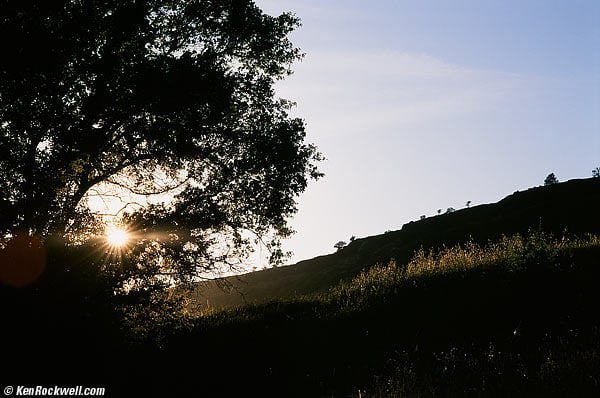
Sunstar, Bear Hole, Big Chico Creek, Upper Bidwell Park, Chico, CA. enlarge.
LEICA 90mm APO-SUMMICRON-ASPH, f/5.6 at 1/60, LEICA M7, Velvia 50, PM, 18 April 2009.
Usage top
Intro Specs Performance Usage Compared Recommendations
Focus Film Flatness Optimum Aperture Half-stop free Minolta CLE
As covered above, the first thing you must do is shoot some film at f/2 to confirm that your lens is well matched to your camera's rangefinder.
Take pictures at f/2, and be sure the optimum focus falls exactly where you intend, not a few inches ahead or behind.
Even if you've gotten perfect results with a fast 50mm lens, your camera could still be off enough to rob you of the sharpness of which a 90mm lens is capable.
Long lenses are far more demanding of mechanical calibration accuracy than 50mm and shorter lenses.
Be careful: if your film has sat overnight, as you wind to the next frame you may have a slight kink in the film from where it sat on the edge of the spool. This often leads to having a slight lack of flatness for the next frame of film.
This subtlety happens in most cameras; I haven't specifically seen it in LEICA, but if you're checking focus accuracy, be aware that this can throw a frame off.
LEICA tells us that f/4 is optimum, and for all I can see this is true, but it only applies if your subject is completely flat, or entirely at infinity.
For real photographs, stop down as needed for depth-of-field.
If it's flat, it's probably going to be a boring photograph anyway.
Sneaky Extra Half-Stop usage top
My sample has a little bit of play in the aperture ring such that I can move it a hair past f/16.
This hair past f/16 just happens to get me a half-stop, or f/19, if I push it.
Use on the Minolta CLE usage top
Try yours yourself: this 90/2 ASPH focuses well behind the intended subject on my Minolta CLE, while the 90mm f/2.8 ELMARIT-M (1990-2008) and tiny 90mm f/2.8 TELE-ELMARIT-M focus perfectly on my CLE.
In other words, even though all these lenses work great on an M7, they work differently on a CLE.
TELE lenses will drive you to insanity if you try to get all your lenses and bodies to match. Be careful not to care too much.
I'm unsure if this lens is a good idea on a CLE; the tiny TELE-ELMARIT-M is more in character to the tiny CLE.
Compared to other 90mm lenses top
Intro Specs Performance Usage Compared Recommendations
See also my Comparison of LEICA 90mm f/2.8 Lenses.
90mm f/2 ASPH |
|||||
| Produced | 1998 - |
2008 - |
1990-2008 |
1980-1998 |
1958-1980 |
| Optics | 5/5 ASPH |
5/4 |
4/4 |
5/4 |
6/5 |
| Filter thread | 55mm |
46mm |
46mm |
49mm, 55mm |
48mm |
| Length | 77.3mm |
66.5mm |
75.9mm |
63.7mm, 77mm |
104mm |
| Weight (actual) | 475g |
345g |
395g |
410g, 484g (684g, silver) |
605-635g |
| Diaphragm Blades | 11 |
11 |
9 |
11 |
12 or 15 |
| Minimum Aperture | f/16 |
f/16 |
f/22 |
f/16 |
f/16 or f/22 |
| Made in | Germany |
Germany |
Germany |
Canada |
Canada |
| Sharpness* | Extraordinary |
Fantastic |
Fantastic |
Excellent |
Very Good |
| Price (3/09, USA) | $2,000 ($700 used) |
$600 used |
|||
| Price (2/10, USA) | $2,000 ($700 used) |
$700 used |
|||
| Price (12/10, USA) | $1,200 used |
$1,100 used |
* Your camera's rangefinder calibration is going to make more of a difference in sharpness than the difference among these lenses. If, and only if, you got a perfectly adjusted system will you be able to notice any differences.
90mm f/2 ASPH |
|||||
| Produced | 1998 - |
2008 - |
1990-2008 |
1959-1974 |
1974-1990 |
| Optics | 5/5 ASPH |
5/4 |
4/4 |
5/3 |
4/4 |
| Filter thread | 55mm |
46mm |
46mm |
39mm |
39mm |
| Length | 77.3mm |
66.5mm |
75.9mm |
87.00mm |
61.3mm |
| Weight (actual) | 475g |
345g |
395g |
335g |
226g |
| Diaphragm Blades | 11 |
11 |
9 |
12 |
10 |
| Minimum Aperture | f/16 |
f/16 |
f/22 |
f/22 |
f/16 |
| Made in | Germany |
Germany |
Germany |
Germany |
Canada, later Germany |
| Sharpness* | Extraordinary |
Fantastic |
Fantastic |
Very Good |
|
| Price (3/09, USA) | $2,000 ($700 used) |
$250 used |
|||
| Price (2/10, USA) | $2,000 ($700 used) |
$300 used |
* Your camera's rangefinder calibration is going to make more of a difference in sharpness than the difference among these lenses. If, and only if, you got a perfectly adjusted system will you be able to notice any differences.
Recommendations top
Intro Specs Performance Usage Compared Recommendations
If you don't mind the size and weight, this LEICA APO-SUMMICRON-M 90mm f/2 ASPH is the best telephoto lens ever made.
If most of your shooting is at f/2, f/2.8 and f/4, this is the best 90mm lens to get.
This 90mm f/2 APO ASPH is smaller and lighter than LEICA's first 90mm f/2, and isn't much bigger than the recently discontinued 90mm f/2.8 ELMARIT-M. For a small additional weight penalty, you get one f/stop, free!
I often do mind a lens this size, since a big lens negates much of the beauty of shooting a small rangefinder camera. In daylight, I usually shoot at f/5.6, where even the tiny tele lens is just as sharp on film.
The new 90mm f/2.5 Summarit-M is as sharp as the 90/2 APO in practice, and much smaller. Sadly, it's not made as well and you can feel the difference. For my $1,600, I'd buy a better used LEICA lens instead.
The tiny 90mm f/2.8 TELE-ELMARIT-M (1974-1990, 39mm filters) is as sharp at f/5.6, but less sharp at f/4 and f/2.8. This is rarely visible in actual shooting, but if you look too close and shoot at f/4 and larger, any of the other 90mm lenses is sharper than the TELE-ELMARIT-M. Since much of my shooting is at f/5.6, and since the TELE-ELMARIT-M is still really sharp at f/2.8, it's usually my favorite 90mm lens.
I keep this bigger f/2 90mm for when I know I'm going to be shooting in dim light, or don't mind hauling it around.
The biggest optical benefits of this big ASPH lens over the tiny tele are seen if you shoot at f/2, f/2.8 and f/4. By f/5.6, the advantage is gone.
I can't see any sharpness difference between this 90mm f/2 ASPH, the 90mm f/2.8 ELMARIT-M and the f/2.5 Summarit-M. The reason to get this f/2 lens is the additional speed, and not much weight penalty over the 90mm f/2.8 ELMARIT-M.
Most of the time you need to stop down to get depth of field, at which point this big, fat f/2 lens gives you little benefit over any of the smaller lenses.
It all comes down to how much you want to carry, and what filter sizes match the rest of your system.
The LEICAMAN cares not the price. The LEICA man only wants the best, which is this APO-SUMMICRON-M 90mm f/2 ASPH.
Deployment
I'd use a 55mm 81A B+W brand filter for slide film.
I'd use any 55mm B+W brand yellow filter for B&W film outdoors, or a 55mm LEICA brand 13 373 UV filter indoors.
I'd use a 55mm LEICA brand 13 373 UV filter for color print film for the LEICA M9.
The old LEICA M8 needs a LEICA brand 55mm UV/IR filter 13 413 (or a B+W brand 55mm UV/IR filter) to correct for a design flaw in the LEICA M8's sensor system design.
More Information:
Help me help you top
I support my growing family through this website, as crazy as it might seem.
The biggest help is when you use any of these links to Adorama, Amazon, eBay, B&H, Ritz, Calumet, J&R and ScanCafe when you get anything, regardless of the country in which you live. It costs you nothing, and is this site's, and thus my family's, biggest source of support. These places have the best prices and service, which is why I've used them since before this website existed. I recommend them all personally.
If you find this page as helpful as a book you might have had to buy or a workshop you may have had to take, feel free to help me continue helping everyone.
If you've gotten your gear through one of my links or helped otherwise, you're family. It's great people like you who allow me to keep adding to this site full-time. Thanks!
If you haven't helped yet, please do, and consider helping me with a gift of $5.00.
As this page is copyrighted and formally registered, it is unlawful to make copies, especially in the form of printouts for personal use. If you wish to make a printout for personal use, you are granted one-time permission only if you PayPal me $5.00 per printout or part thereof. Thank you!
Thanks for reading!
Mr. & Mrs. Ken Rockwell, Ryan and Katie.
Home Donate New Search Gallery Reviews How-To Books Links Workshops About Contact






